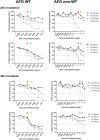Optimization of the EUCAST reference broth microdilution method for echinocandin susceptibility testing of Aspergillus fumigatus
- PMID: 37811550
- PMCID: PMC11259975
- DOI: 10.1093/jac/dkad306
Optimization of the EUCAST reference broth microdilution method for echinocandin susceptibility testing of Aspergillus fumigatus
Abstract
Background: Because of the high inoculum (105 cfu/mL) used in the EUCAST susceptibility testing of Aspergillus spp., determination of the minimal effective concentration (MEC) of echinocandins is challenging as the morphological differences are subtle.
Methods: The MECs of 10 WT and 4 non-WT Aspergillus fumigatus isolates were determined with the EUCAST E.Def 9.4. Plates were inoculated with increasing inocula (102-105 cfu/mL) and after 24 and 48 h of incubation, MECs were determined macroscopically (magnifying mirror) and microscopically (inverted microscope) by two observers, spectrophotometrically (OD at 405 nm) and colorimetrically (absorbance at 450/630 nm after 2 h incubation with 400 mg/L XTT/6.25 μM menadione). The interobserver (between observers)/intermethod (compared with the microscopic method) essential agreement (EA, ±1 2-fold dilution) and categorical agreement (CA) were determined for each inoculum.
Results: Echinocandin-induced microscopic hyphal alterations or macroscopic changes in turbidity were subtle with a 105 cfu/mL inoculum compared with the lower inocula of 103 and 102 cfu/mL, where more distinct changes in turbidity and formation of characteristic rosettes were obvious at the MEC after 48 h. A 105 cfu/mL inoculum resulted in wider MEC distributions (3-6 dilutions) and lower interobserver EA (69%), macroscopic-microscopic EA (26%) and CA (71%) compared with a 103 cfu/mL inoculum (2-3 dilutions, 100%, 100% and 100%, respectively). Spectrophotometric readings using a 103 cfu/mL inoculum showed good EA (57-93%) and excellent CA (86%-100%), while the XTT assay demonstrated excellent EA (93%) and CA (100%).
Conclusions: A 48 h incubation using a 103 cfu/mL inoculum improved echinocandin MEC determination for A. fumigatus with the EUCAST method, while the colorimetric assay could allow automation.
© The Author(s) 2023. Published by Oxford University Press on behalf of British Society for Antimicrobial Chemotherapy. All rights reserved. For permissions, please e-mail: journals.permissions@oup.com.
Figures




References
MeSH terms
Substances
LinkOut - more resources
Full Text Sources
Miscellaneous

